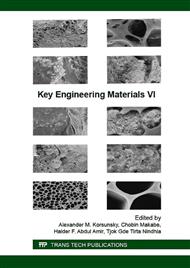p.138
p.145
p.150
p.155
p.163
p.168
p.174
p.179
p.186
In Situ Electrochemical Study of Copper Nanoparticles Stabilized with Food Grade Gelatin
Abstract:
Commercially available conductive inks are typically made up of precious metal nanoparticles, such as gold (Au) and silver (Ag). Thus, cheaper metals like copper (Cu) are currently being explored as alternative material. Though Cu has a comparable conductivity to that of Ag, they tend to oxidize easily when exposed to air and water, which could limit their application. In this work, oxidation-stable Cu nanoparticles with mean diameter as small as 57 nm were prepared by simple electroless deposition in water. Food-grade gelatin was used as stabilizer, which makes the process more economical and environment-friendly. In situ monitoring of mixed potential was carried out during synthesis to understand the kinetics of the reaction. The mixed potential of the solution shifted negatively as the amount of gelatin was increased. This suggests faster reduction rate.
Info:
Periodical:
Pages:
163-167
Citation:
Online since:
August 2016
Authors:
Keywords:
Price:
Сopyright:
© 2016 Trans Tech Publications Ltd. All Rights Reserved
Share:
Citation:


